Experimental Evaluation of the Packet Reception Performance of LoRa
Abstract
1. Introduction
- (1)
- We studied the influence of physical layer parameters on the reliability of communication links between LoRa nodes, and obtained detailed experimental results on the relationship between the two;
- (2)
- The influence of the packet length on the reliability of communication links between LoRa nodes was studied by a theoretical analysis and extensive experiments. It should be noted that it is not worth using short packets instead of long packets;
- (3)
- We analyzed the influence of the physical layer parameter settings on the retransmission effect and proposed how to configure the physical layer parameters to minimize the energy consumption and maintain a high data rate, so as to achieve a balance between reliability, delay, and energy efficiency.
2. Related Work
3. LoRa
4. Study on the Relationship between Physical Layer Parameters and the Performance of LoRa
4.1. Brief Description of the Transceivers Used in the Experiments
4.2. LoRa Evaluation Experiment Setup
5. Results and Analysis
5.1. The Impact of SF on the Packet Reception Performance of LoRa
- (i)
- As the SNR decreases (the noise intensity becomes larger), the PER value increases, that is, the noise signal covers the LoRa signal. The LoRa signal is distorted and demodulation errors occur. In addition, as the SF value increases, the PER value becomes smaller. Therefore, a higher SF has better noise immunity. For example, for SNR = −12 dB, when SF = 7, PER = 1, but when SF = 12, PER = 0.034.
- (ii)
- Each time SF increases by one, SNR in the high PER area (PER ≈ 1) decreases by 2 or 3 dB. For instance, from SF = 9 to SF = 10 for BW = 125 kHz, the high PER region’s SNR changes from −16 to −18 dB.
5.2. The Impact of BW on the Packet Reception Performance of LoRa
5.3. The Impact of CR on the Packet Reception Performance of LoRa
5.4. The Impact of the Packet Length on the Packet Reception Performance of LoRa
5.4.1. Theoretical Analysis of the Impact of the Packet Length
5.4.2. The Result of the Impact of the Packet Length on the Packet Reception Performance of LoRa
5.5. Measurement Results of Different LoRa Receivers
5.6. Parameter Setting of the Transmission Scheme
6. Future Work
7. Conclusions
Author Contributions
Funding
Institutional Review Board Statement
Informed Consent Statement
Data Availability Statement
Acknowledgments
Conflicts of Interest
Abbreviations
| IoT | Internet of Things |
| SF | Spreading Factor |
| BW | Bandwidth |
| CR | Coding Rate |
| SFD | Start Frame Delimiter |
| PER | Packet Error Ratio |
| SNR | Signal to Noise Ratio |
| CSS | Chirp Spread Spectrum |
| LPWAN | Low Power Wide Area Network |
| IFFT | Inverse Fast Fourier Transform |
| FFT | Fast Fourier Transform |
| Rs | Symbol Rate |
| DR | Data Rate |
| CRC | Cyclic Redundancy Check |
| FEC | Forward Error Correction |
References
- Cerwall, P.; Jonsson, P.; Möller, R.; Bävertoft, S.; Carson, S.; Godor, I. On the pulse of the networked society—Hg. v. Ericsson. In Ericsson Mobility Report; Ericsson: Stockholm, Sweden, 2015. [Google Scholar]
- Gondchawar, N.; Kawitkar, R. IoT based smart agriculture. Int. J. Adv. Res. Comput. Commun. Eng. 2016, 5, 838–842. [Google Scholar]
- Stojkoska, B.L.R.; Trivodaliev, K.V. A review of Internet of Things for smart home: Challenges and solutions. J. Clean. Prod. 2017, 140, 1454–1464. [Google Scholar] [CrossRef]
- Baker, S.B.; Xiang, W.; Atkinson, I. Internet of things for smart healthcare: Technologies, challenges, and opportunities. IEEE Access 2017, 5, 26521–26544. [Google Scholar] [CrossRef]
- Ramson, S.J.; Moni, D.J. Applications of wireless sensor networks—A survey. In Proceedings of the 2017 International Conference on Innovations in Electrical, Electronics, Instrumentation and Media Technology (ICEEIMT), Coimbatore, India, 3–4 February 2017; pp. 325–329. [Google Scholar]
- Lin, J.; Yu, W.; Zhang, N.; Yang, X.; Zhang, H.; Zhao, W. A survey on internet of things: Architecture, enabling technologies, security and privacy, and applications. IEEE Internet Things 2017, 4, 1125–1142. [Google Scholar] [CrossRef]
- Raza, U.; Kulkarni, P.; Sooriyabandara, M. Low power wide area networks: An overview. IEEE Commun. Surv. Tutor. 2017, 19, 855–873. [Google Scholar] [CrossRef]
- Semtech. Available online: https://www.semtech.com/ (accessed on 29 January 2021).
- LoRa® and LoRaWAN®. A Technical Overview. Available online: https://lora-developers.semtech.com/uploads/documents/files/LoRa_and_LoRaWAN-A_Tech_Overview-Downloadable.pdf (accessed on 29 January 2021).
- Yousuf, A.M.; Rochester, E.M.; Ousat, B.; Ghaderi, M. Throughput, coverage and scalability of LoRa LPWAN for internet of things. In Proceedings of the 2018 IEEE/ACM 26th International Symposium on Quality of Service (IWQoS), Banff, AB, Canada, 4–6 June 2018; pp. 1–10. [Google Scholar]
- Noreen, U.; Bounceur, A.; Clavier, L. A study of LoRa low power and wide area network technology. In Proceedings of the 2017 International Conference on Advanced Technologies for Signal and Image Processing (ATSIP), Fes, Morocco, 22–24 May 2017; pp. 1–6. [Google Scholar]
- Sundaram, J.P.S.; Du, W.; Zhao, Z.J.I.C.S. A survey on lora networking: Research problems, current solutions, and open issues. IEEE Commun. Surv. Tutor. 2019, 22, 371–388. [Google Scholar] [CrossRef]
- Wang, S.-Y.; Chen, Y.-R.; Chen, T.-Y.; Chang, C.-H.; Cheng, Y.-H.; Hsu, C.-C.; Lin, Y.-B. Performance of LoRa-based IoT applications on campus. In Proceedings of the 2017 IEEE 86th Vehicular Technology Conference (VTC-Fall), Toronto, ON, Canada, 24–27 September 2017; pp. 1–6. [Google Scholar]
- Petäjäjärvi, J.; Mikhaylov, K.; Hämäläinen, M.; Iinatti, J. Evaluation of LoRa LPWAN technology for remote health and wellbeing monitoring. In Proceedings of the 2016 10th International Symposium on Medical Information and Communication Technology (ISMICT), Worcester MA, USA, 20–23 March 2016; pp. 1–5. [Google Scholar]
- Liang, R.; Zhao, L.; Wang, P. Performance evaluations of LoRa wireless communication in building environments. Sensors 2020, 20, 3828. [Google Scholar] [CrossRef] [PubMed]
- Yim, D.; Chung, J.; Cho, Y.; Song, H.; Jin, D.; Kim, S.; Ko, S.; Smith, A.; Riegsecker, A. An experimental LoRa performance evaluation in tree farm. In Proceedings of the 2018 IEEE Sensors Applications Symposium (SAS), Seoul, Korea, 12–14 March 2018; pp. 1–6. [Google Scholar]
- Sandoval, R.M.; Garcia-Sanchez, A.-J.; Garcia-Haro, J. Performance optimization of LoRa nodes for the future smart city/industry. EURASIP J. Wirel. Commun. Netw. 2019, 2019, 1–13. [Google Scholar] [CrossRef]
- Vangelista, L. Frequency shift chirp modulation: The LoRa modulation. IEEE Signal Process. Lett. 2017, 24, 1818–1821. [Google Scholar] [CrossRef]
- Reynders, B.; Pollin, S. Chirp spread spectrum as a modulation technique for long range communication. In Proceedings of the 2016 Symposium on Communications and Vehicular Technologies (SCVT), Mons, Belgium, 22 November 2016; pp. 1–5. [Google Scholar]
- Angrisani, L.; Arpaia, P.; Bonavolontà, F.; Conti, M.; Liccardo, A. LoRa protocol performance assessment in critical noise conditions. In Proceedings of the 2017 IEEE 3rd International Forum on Research and Technologies for Society and Industry (RTSI), Modena, Italy, 11–13 September 2017; pp. 1–5. [Google Scholar]
- Sanchez-Iborra, R.; Sanchez-Gomez, J.; Ballesta-Viñas, J.; Cano, M.-D.; Skarmeta, A.F. Performance evaluation of LoRa considering scenario conditions. Sensors 2018, 18, 772. [Google Scholar] [CrossRef] [PubMed]
- Cattani, M.; Boano, C.A.; Römer, K. An experimental evaluation of the reliability of lora long-range low-power wireless communication. J. Sensor Actuat. Netw. 2017, 6, 7. [Google Scholar]
- Liando, J.C.; Gamage, A.; Tengourtius, A.W.; Li, M. Known and unknown facts of LoRa: Experiences from a large-scale measurement study. ACM Trans. Sens. Netw. TOSN 2019, 15, 1–35. [Google Scholar] [CrossRef]
- Bor, M.C.; Roedig, U.; Voigt, T.; Alonso, J.M. Do LoRa low-power wide-area networks scale? In Proceedings of the 19th ACM International Conference on Modeling, Analysis and Simulation of Wireless and Mobile Systems, Valletta, Malta, 13–17 November 2016; pp. 59–67. [Google Scholar]
- Lavric, A.; Petrariu, A.I.; Coca, E.; Popa, V. LoRa traffic generator based on software defined radio technology for LoRa modulation orthogonality analysis: Empirical and experimental evaluation. Sensors 2020, 20, 4123. [Google Scholar] [CrossRef] [PubMed]
- Magrin, D.; Centenaro, M.; Vangelista, L. Performance evaluation of LoRa networks in a smart city scenario. In Proceedings of the 2017 IEEE International Conference on Communications (ICC), Paris, France, 21–25 May 2017; pp. 1–7. [Google Scholar]
- Bor, M.; Vidler, J.E.; Roedig, U. LoRa for the Internet of Things. In Proceedings of the 1st International Workshop on New Wireless Communication Paradigms for the Internet of Things (MadCom), Graz, Austria, 15–17 February 2016; pp. 361–366. [Google Scholar]
- Kufakunesu, R.; Hancke, G.P.; Abu-Mahfouz, A.M. A survey on adaptive data rate optimization in LoRaWAN: Recent solutions and major challenges. Sensors 2020, 20, 5044. [Google Scholar] [CrossRef] [PubMed]
- Augustin, A.; Yi, J.; Clausen, T.; Townsley, W.M. A study of LoRa: Long range & low power networks for the internet of things. Sensors 2016, 16, 1466. [Google Scholar]
- Knight, M.; Seeber, B.; Net, B. Decoding LoRa: Realizing a Modern LPWAN with SDR. Available online: https://pubs.gnuradio.org/index.php/grcon/article/view/8 (accessed on 29 January 2021).
- Bor, M.; Roedig, U. LoRa transmission parameter selection. In Proceedings of the 2017 13th International Conference on Distributed Computing in Sensor Systems (DCOSS), Ottawa, ON, Canada, 5 June 2017; pp. 27–34. [Google Scholar]
- SX1272 LoRa Calculator. Available online: https://www.semtech.com/search/results?keywords=calculator%2A (accessed on 29 January 2021).
- Han, J.-S.; Lee, Y.-H. Interference-robust transmission in wireless sensor networks. Sensors 2016, 16, 1910. [Google Scholar] [CrossRef] [PubMed]
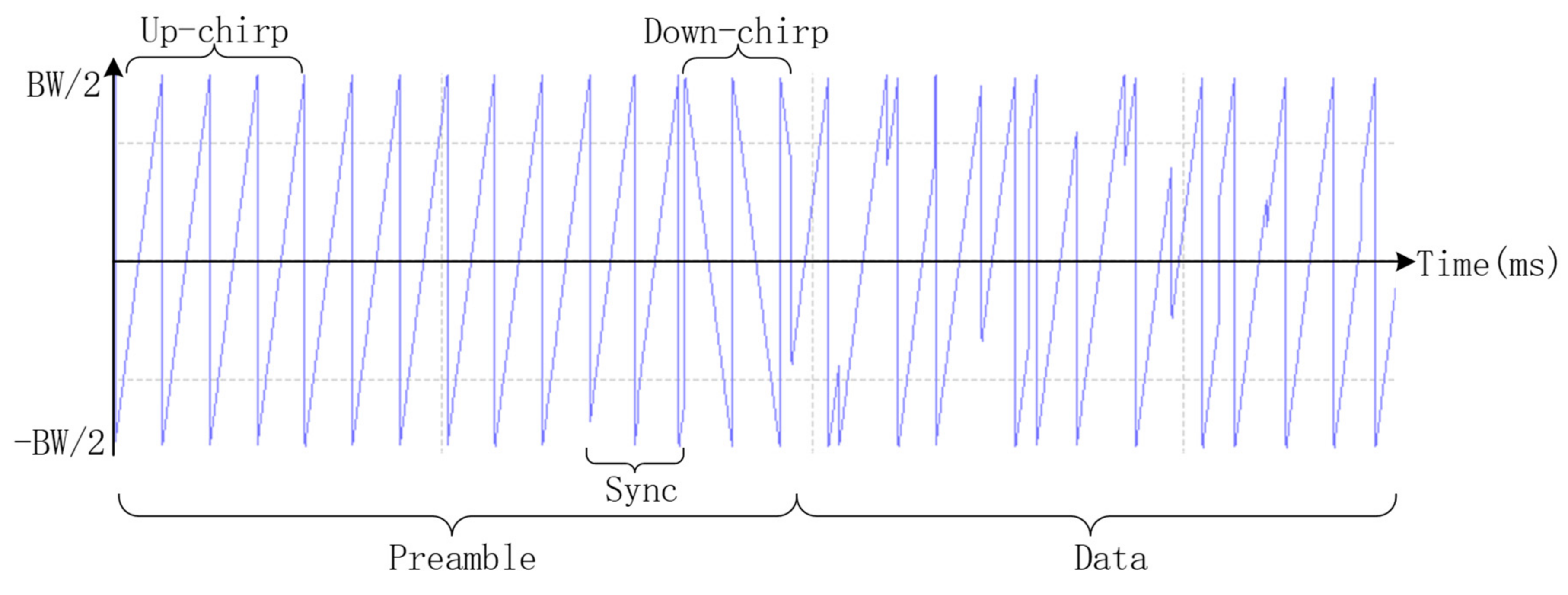


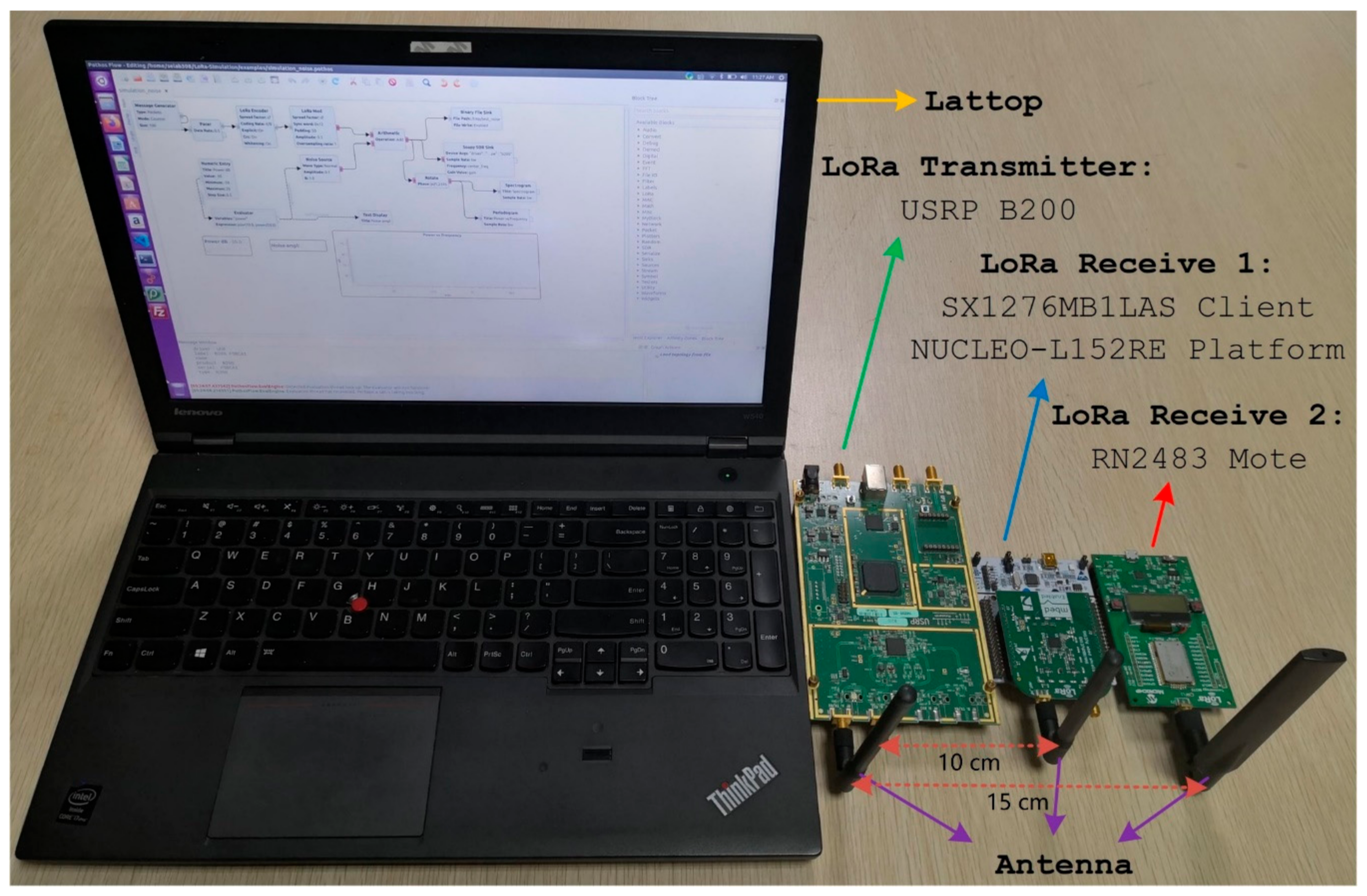
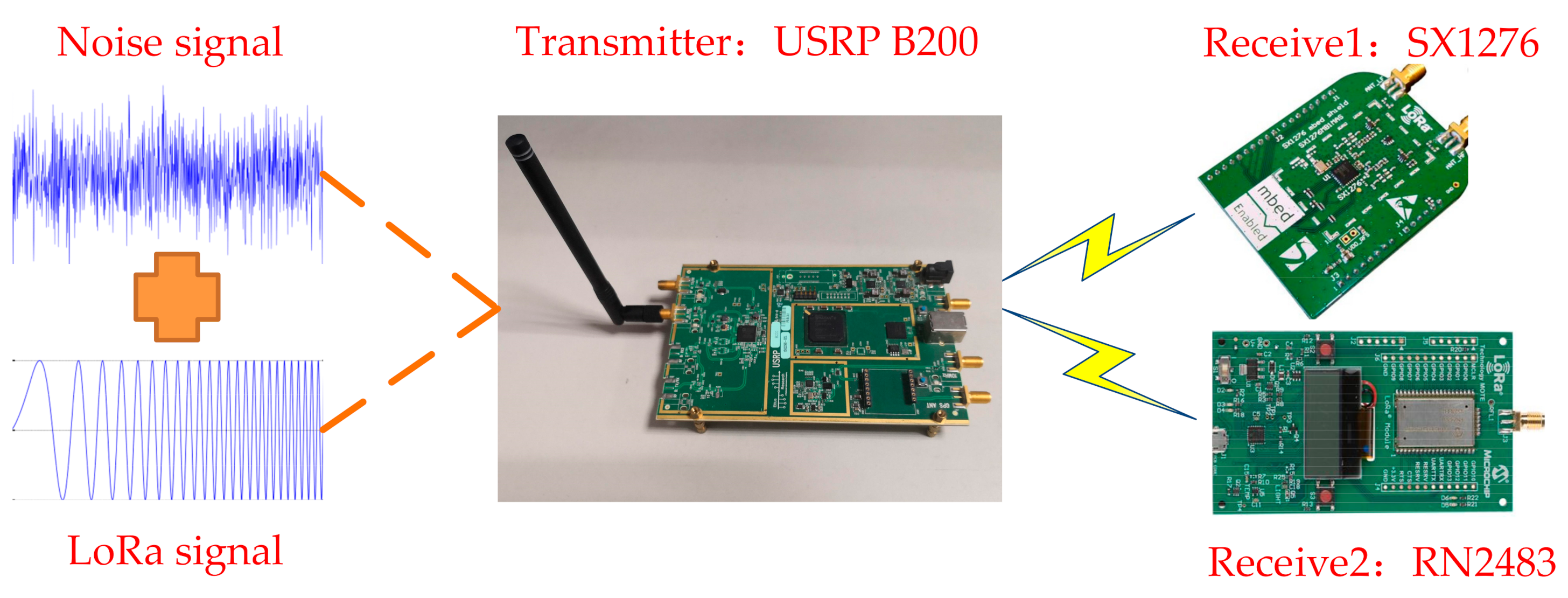



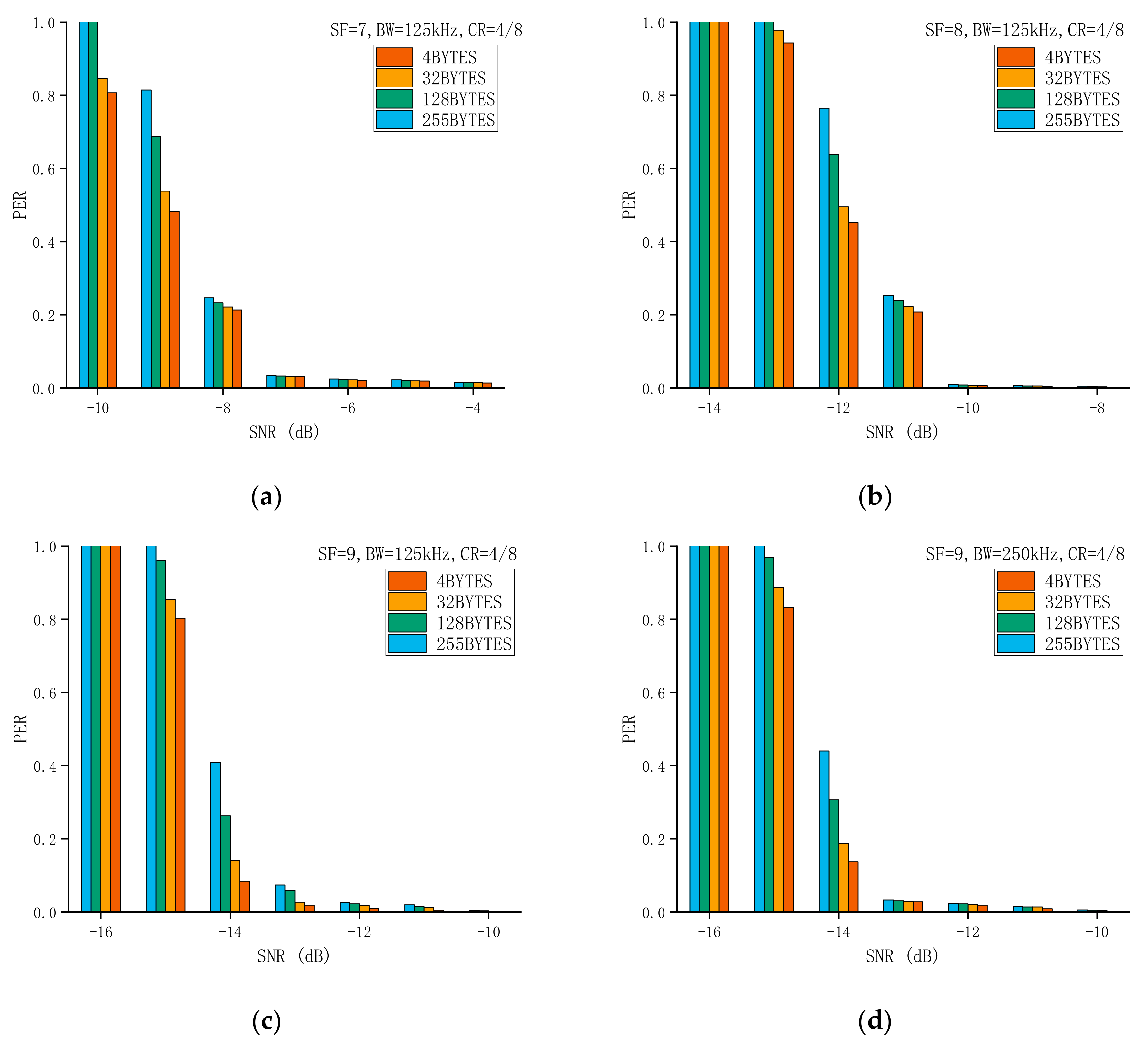
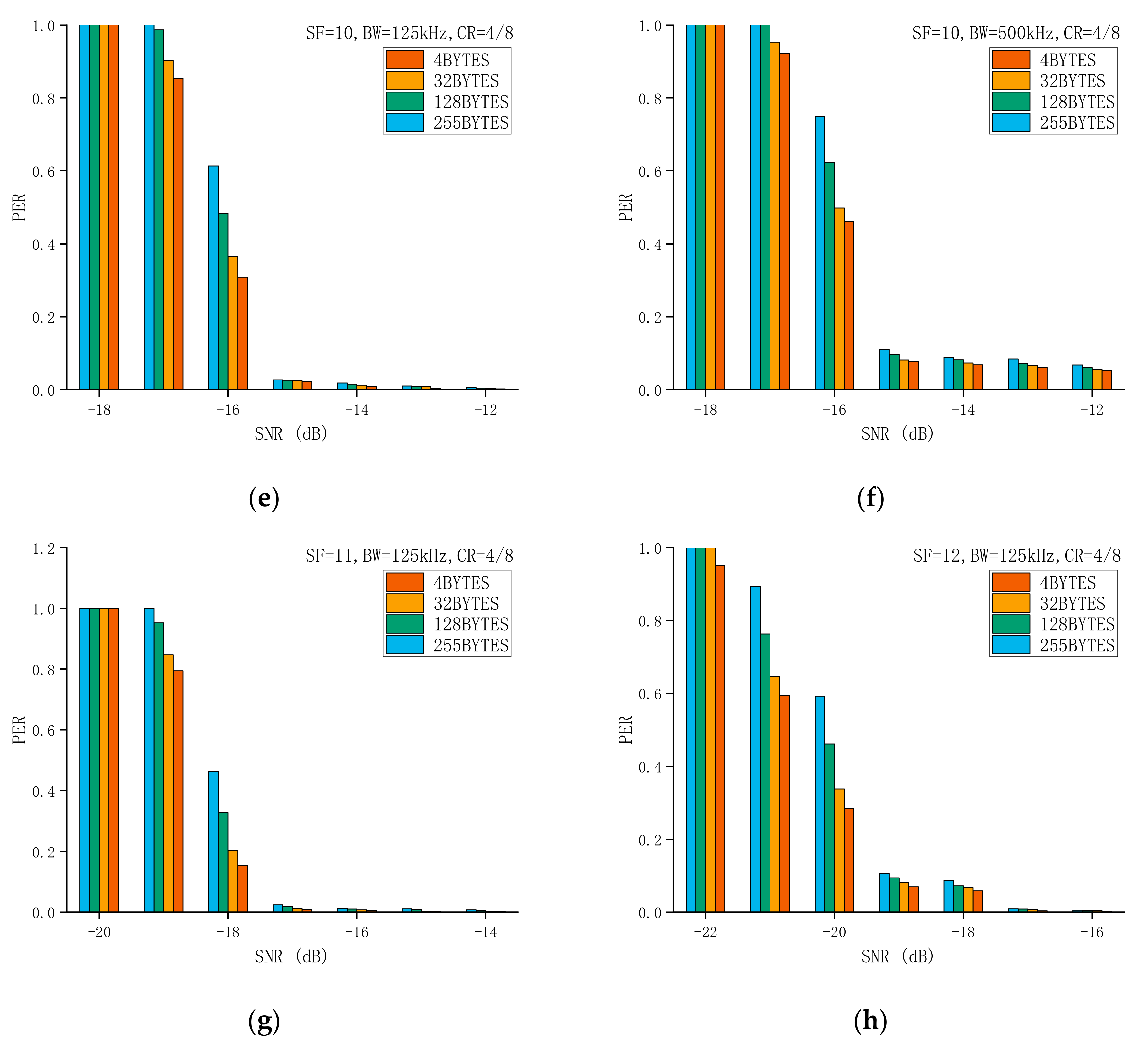

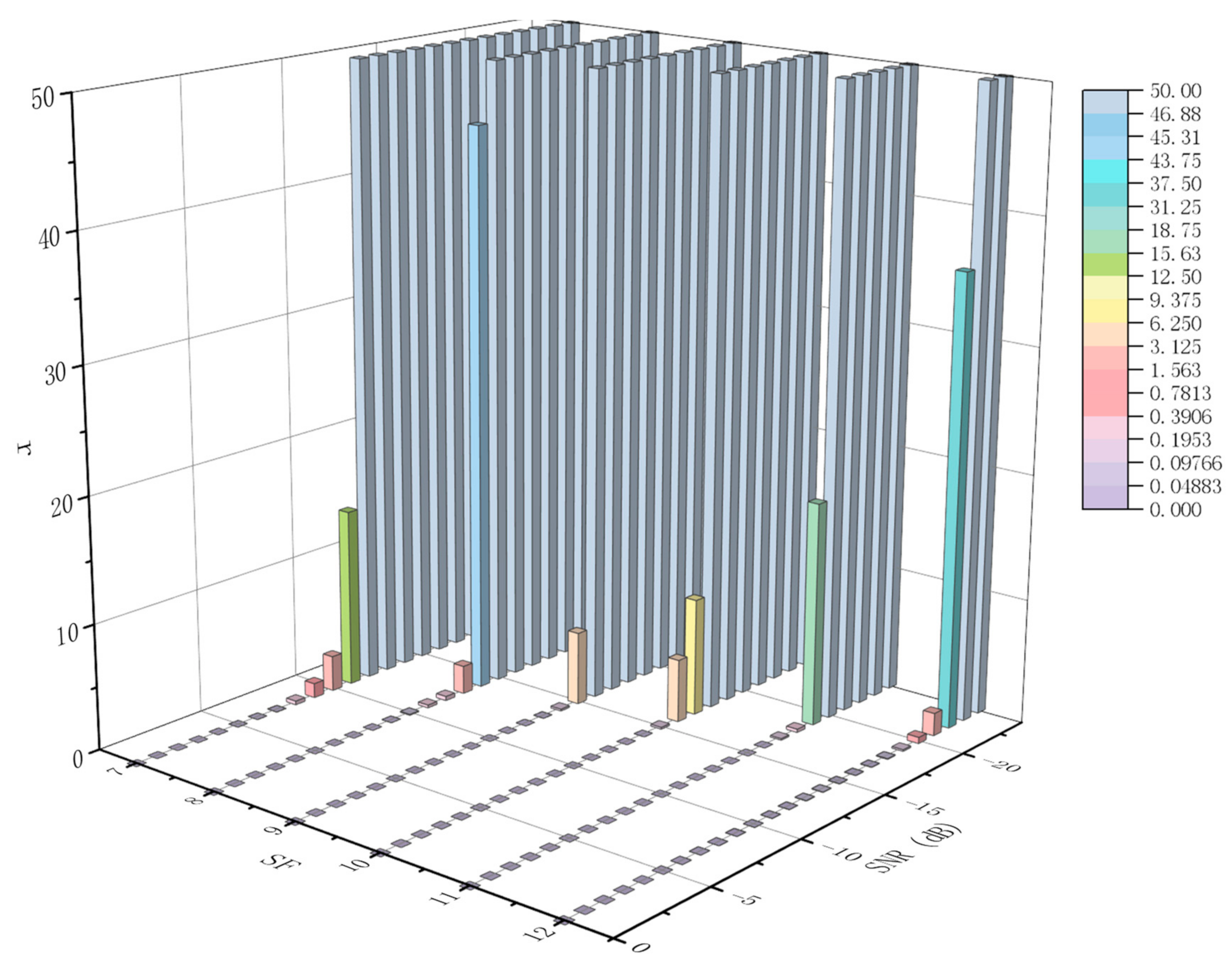
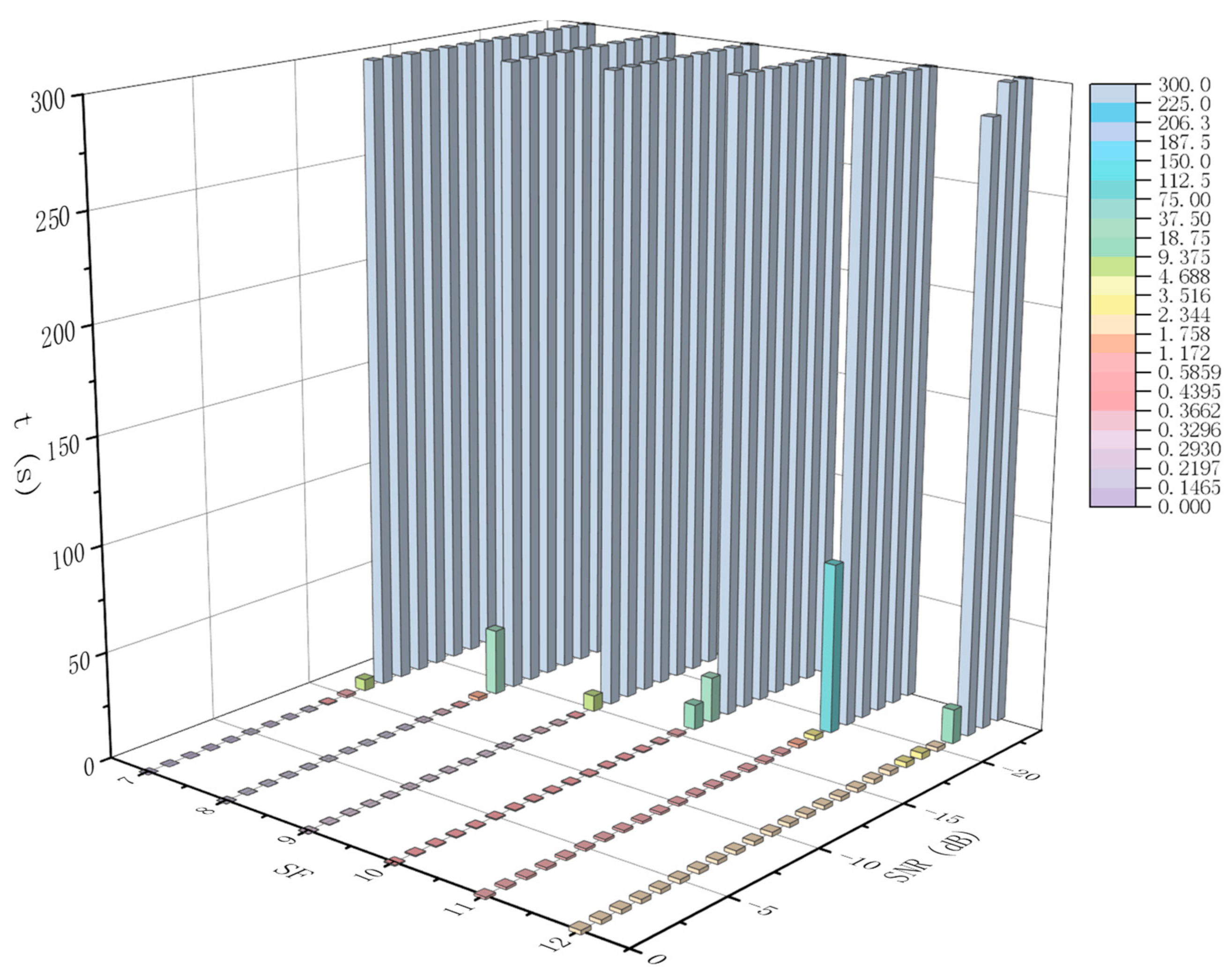


| SF | BW | Time-on-Air (msec) | Data Rate (kbps) | Sensitivity (dBm) |
|---|---|---|---|---|
| 7 | 125 | 44.29 | 5.47 | −123 |
| 7 | 250 | 22.14 | 10.94 | −120 |
| 7 | 500 | 11.07 | 21.88 | −117 |
| 8 | 125 | 88.58 | 3.13 | −126 |
| 8 | 250 | 44.29 | 6.25 | −123 |
| 8 | 500 | 22.14 | 12.50 | −120 |
| 9 | 125 | 144.38 | 1.76 | −129 |
| 9 | 250 | 72.19 | 3.52 | −126 |
| 9 | 500 | 36.01 | 7.03 | −123 |
| 10 | 125 | 288.77 | 0.98 | −132 |
| 10 | 250 | 144.38 | 1.95 | −129 |
| 10 | 500 | 72.19 | 3.91 | −126 |
| 11 | 125 | 577.54 | 0.54 | −134.5 |
| 11 | 250 | 288.77 | 1.07 | −131.5 |
| 11 | 500 | 144.38 | 2.15 | −128.5 |
| 12 | 125 | 1155.07 | 0.29 | −137 |
| 12 | 250 | 577.54 | 0.59 | −134 |
| 12 | 500 | 288.77 | 1.17 | −131 |
| SF | PER | |||
|---|---|---|---|---|
| 7 | 0.5380 | 96.51 | 386.04 | 546.05 |
| 8 | 0.0050 | 176.64 | 706.56 | 180.19 |
| 9 | 0.0019 | 320.51 | 1282.04 | 322.95 |
| 10 | 0.0011 | 575.49 | 2301.96 | 578.02 |
| 11 | 0.0003 | 1150.98 | 4603.92 | 1152.36 |
| 12 | 0.0000 | 2039.81 | 8159.24 | 2039.81 |
Publisher’s Note: MDPI stays neutral with regard to jurisdictional claims in published maps and institutional affiliations. |
© 2021 by the authors. Licensee MDPI, Basel, Switzerland. This article is an open access article distributed under the terms and conditions of the Creative Commons Attribution (CC BY) license (http://creativecommons.org/licenses/by/4.0/).
Share and Cite
Guo, Q.; Yang, F.; Wei, J. Experimental Evaluation of the Packet Reception Performance of LoRa. Sensors 2021, 21, 1071. https://doi.org/10.3390/s21041071
Guo Q, Yang F, Wei J. Experimental Evaluation of the Packet Reception Performance of LoRa. Sensors. 2021; 21(4):1071. https://doi.org/10.3390/s21041071
Chicago/Turabian StyleGuo, Qingjie, Fengxu Yang, and Jianming Wei. 2021. "Experimental Evaluation of the Packet Reception Performance of LoRa" Sensors 21, no. 4: 1071. https://doi.org/10.3390/s21041071
APA StyleGuo, Q., Yang, F., & Wei, J. (2021). Experimental Evaluation of the Packet Reception Performance of LoRa. Sensors, 21(4), 1071. https://doi.org/10.3390/s21041071







